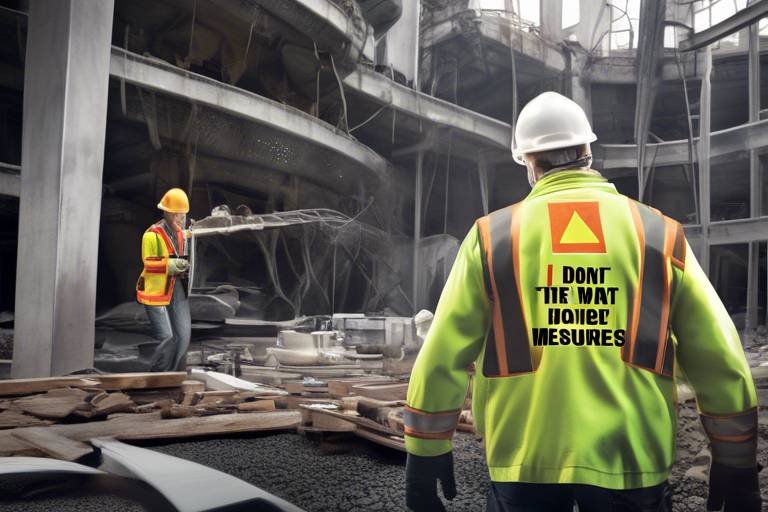Delving Deep into Human Behavior: An Essential for Safety Measures
In today's world, understanding human behavior is not just an academic exercise; it's a critical necessity for ensuring safety across various domains. From workplaces to public spaces, the way individuals act in response to risks can make the difference between safety and disaster. Have you ever wondered why people sometimes ignore obvious dangers? Or why certain safety protocols are followed while others are disregarded? These questions lead us into the intricate relationship between psychology and safety measures.
When we delve into human behavior, we uncover a complex tapestry woven from emotions, cognitive processes, and social influences. Each thread plays a significant role in how individuals perceive risks and make decisions. For instance, in a high-stakes environment like a construction site, the decisions made by workers can be influenced by their understanding of safety protocols, their emotional state at the moment, and the social dynamics at play among their peers. This interplay is not just fascinating; it is essential for developing effective safety measures that truly resonate with human behavior.
Moreover, as we navigate through this exploration, it becomes evident that safety measures need to be designed with a deep understanding of these psychological factors. This means that safety training should not only focus on the technical aspects of safety protocols but also on the human elements that influence compliance and behavior. By doing so, we can create a safer environment where individuals are not just following rules but are actively engaged in promoting their own safety and that of others.
In the sections that follow, we will explore various aspects of human behavior in relation to safety measures, including the psychology of risk perception, the decision-making processes that guide our actions, and the emotional and social influences that shape our responses to potential dangers. By examining these factors, we aim to uncover insights that can lead to more effective safety protocols and ultimately, a safer world for everyone.
Understanding how individuals perceive risk is crucial for developing safety measures. This section delves into the cognitive biases that influence risk assessment and decision-making in various environments.
Human behavior is often driven by complex decision-making processes. This section examines the factors that affect choices in safety-critical situations, highlighting the importance of awareness and education.
Cognitive biases can significantly impact safety decisions. This subheading explores common biases, such as optimism bias and confirmation bias, and how they can lead to unsafe behaviors.
Strategies to mitigate cognitive biases are essential for improving safety. This section offers practical approaches to help individuals recognize and counteract their biases in risk-related scenarios.
Training programs play a vital role in shaping safe behaviors. This part discusses how education can enhance awareness and improve decision-making in high-risk environments.
Emotions often drive human behavior, especially in emergencies. This section investigates how fear, stress, and anxiety affect responses to safety protocols and decision-making.
Social dynamics can significantly impact individual behavior regarding safety. This section explores how group norms, peer pressure, and cultural factors shape safety practices.
Groupthink can lead to dangerous complacency in safety practices. This subheading discusses the phenomenon and its implications for organizational safety culture and compliance.
Creating a robust safety culture requires active participation. This section outlines strategies for fostering an environment where safety is prioritized and encouraged among all members of an organization.
- What is the importance of understanding human behavior in safety measures?
Understanding human behavior helps in designing safety protocols that are more effective and resonate with individuals, leading to better compliance and fewer accidents. - How do cognitive biases affect safety decisions?
Cognitive biases can lead individuals to underestimate risks or ignore safety protocols, which can result in unsafe behaviors. - What role does training play in improving safety?
Training enhances awareness and equips individuals with the knowledge to make informed decisions in safety-critical situations. - How can organizations promote a safety culture?
Organizations can promote a safety culture by encouraging open communication, providing regular training, and recognizing safe practices among employees.

The Psychology of Risk Perception
This article explores the intricate relationship between human behavior and safety measures, emphasizing the importance of understanding psychological factors in creating effective safety protocols and enhancing overall security.
Understanding how individuals perceive risk is crucial for developing effective safety measures. It's fascinating how our minds work when assessing potential dangers. Often, our perceptions are not based purely on facts but are heavily influenced by cognitive biases and emotional responses. For instance, when faced with a risky situation, one might think, "It won't happen to me," which is a classic example of optimism bias. This bias can lead people to underestimate the likelihood of negative outcomes, making them more prone to unsafe behaviors.
Moreover, the context in which risks are presented can significantly alter perception. For example, consider a construction site where workers are exposed to various hazards. If the risks are framed as "minor accidents" rather than "life-threatening incidents," workers may not take necessary precautions. This difference in framing can create a false sense of security, leading to a dangerous complacency. It’s essential to recognize these psychological mechanisms to create effective safety protocols.
In addition to cognitive biases, emotional factors play a pivotal role in how we perceive risk. Emotions like fear, stress, and anxiety can cloud judgment, often leading to hasty decisions. For instance, during an emergency, a person overwhelmed by fear may not follow safety protocols effectively, opting instead for a fight-or-flight response. This reaction can jeopardize not only their safety but also the safety of others around them. Understanding these emotional influences is vital for designing safety measures that account for human behavior.
To further illustrate the complexities of risk perception, let’s consider a table that outlines common cognitive biases that affect safety decisions:
| Cognitive Bias | Description | Impact on Safety |
|---|---|---|
| Optimism Bias | The belief that negative events are less likely to happen to oneself. | Leads to underestimating risks and ignoring safety protocols. |
| Confirmation Bias | The tendency to search for, interpret, and remember information that confirms one’s preconceptions. | Can result in ignoring warning signs or evidence of danger. |
| Availability Heuristic | Relying on immediate examples that come to mind when evaluating a specific topic. | May cause individuals to overestimate the likelihood of dramatic incidents while underestimating more common risks. |
Recognizing these biases is the first step in overcoming them. By fostering awareness about how our minds work, we can better equip ourselves to make informed decisions regarding safety. The next step involves implementing strategies that help individuals counteract these biases. For instance, organizations can conduct training sessions to raise awareness about cognitive biases and their implications on safety. This proactive approach not only enhances individual decision-making but also cultivates a culture of safety within the organization.
In conclusion, the psychology of risk perception is a critical component in the realm of safety measures. By understanding the cognitive and emotional factors that influence our perceptions, we can develop more effective safety protocols that resonate with individuals on a psychological level. This understanding not only enhances individual safety but also contributes to a broader culture of safety that benefits everyone.
- What is risk perception? Risk perception refers to the subjective judgment that individuals make about the characteristics and severity of a risk.
- How do cognitive biases affect safety? Cognitive biases can distort our understanding of risks and lead to unsafe behaviors by influencing our decision-making processes.
- Why is emotional awareness important in safety protocols? Emotions can significantly impact decision-making, especially in high-stress situations. Awareness of these emotions can improve compliance with safety measures.
- What strategies can help mitigate cognitive biases? Training, awareness programs, and open discussions about safety can help individuals recognize and counteract their biases.

When it comes to safety, the way we make decisions can be as crucial as the measures we put in place. Understanding human decision-making processes is essential for creating effective safety protocols. Our choices, especially in critical situations, are influenced by a myriad of factors ranging from our emotions to our cognitive biases. Have you ever wondered why some people freeze in emergencies while others spring into action? The answer lies in the intricate dance of decision-making that occurs in our minds.
At the core of decision-making is the concept of risk assessment. This involves evaluating potential dangers and determining the best course of action. However, this process is rarely straightforward. It’s often clouded by cognitive biases, which can distort our perception of reality. For instance, when faced with a risk, many individuals may underestimate the likelihood of negative outcomes due to what is known as optimism bias. This bias can lead to dangerous complacency, as people might think, “It won’t happen to me.” On the other hand, confirmation bias can cause individuals to seek out information that supports their pre-existing beliefs, ignoring evidence that contradicts them. These biases can significantly impact our ability to make sound decisions regarding safety.
In high-pressure situations, stress and anxiety can further complicate our decision-making processes. When emotions run high, our ability to think clearly often diminishes. Imagine being in a crowded venue when an alarm goes off; the initial reaction might be panic, leading to chaotic decisions that can jeopardize safety. This is where awareness and education come into play. By understanding how our emotions can influence our choices, we can better prepare ourselves to respond appropriately in emergencies.
Moreover, the context in which decisions are made can also affect outcomes. For example, in a workplace setting, the presence of a supervisor might create a different dynamic than if the same decision were made alone. Group dynamics can lead to groupthink, where individuals conform to the prevailing opinion, often at the expense of their own judgment. This phenomenon can be particularly dangerous in safety-critical environments, where the stakes are high, and complacency can lead to catastrophic results.
To combat these issues, organizations must implement training programs that focus on decision-making skills. Such programs can equip individuals with the tools to recognize their biases and emotional triggers, fostering a culture of safety where informed decisions are the norm. For instance, simulations and role-playing exercises can help individuals practice their responses to various scenarios, enhancing their confidence and decision-making abilities in real-life situations.
In conclusion, understanding human decision-making processes is not just an academic exercise; it is vital for enhancing safety. By recognizing the influence of cognitive biases, emotional responses, and social dynamics, we can create more effective safety protocols that empower individuals to make informed decisions, ultimately leading to a safer environment for everyone.
- What are cognitive biases? Cognitive biases are systematic patterns of deviation from norm or rationality in judgment, which can lead to illogical conclusions and poor decision-making.
- How can training improve decision-making in safety? Training can help individuals recognize their biases, manage their emotions, and practice decision-making in realistic scenarios, leading to better outcomes in emergencies.
- What is groupthink? Groupthink is a psychological phenomenon where the desire for harmony in a decision-making group leads to irrational or dysfunctional decision-making outcomes.

When it comes to safety, our minds can sometimes play tricks on us. Cognitive biases are mental shortcuts that can lead to flawed judgment and decision-making, especially in situations that demand our attention and care. These biases can create a false sense of security, making us underestimate risks and overestimate our ability to handle dangerous situations. For instance, consider the optimism bias, where individuals believe they are less likely to experience negative events compared to others. This can lead to reckless behaviors, such as ignoring safety protocols because, deep down, they think, "It won't happen to me."
Another common cognitive bias is confirmation bias, where people tend to seek out information that supports their existing beliefs while disregarding evidence that contradicts them. In the context of safety, this might mean that an individual ignores warnings about the dangers of certain practices because they have always done things a particular way and have not faced any immediate consequences. This can create a dangerous cycle of complacency and ignorance, which can ultimately lead to accidents and injuries.
To illustrate these biases further, let's take a look at a table summarizing some common cognitive biases and their implications for safety:
| Cognitive Bias | Description | Implications for Safety |
|---|---|---|
| Optimism Bias | The belief that one is less likely to experience negative events than others. | Leads to risky behavior and negligence of safety measures. |
| Confirmation Bias | The tendency to search for, interpret, and remember information that confirms one’s preconceptions. | Results in ignoring safety warnings and maintaining unsafe practices. |
| Anchoring Bias | Relying too heavily on the first piece of information encountered. | Can lead to poor decision-making based on outdated or irrelevant information. |
Recognizing these biases is the first step towards mitigating their impact on safety. It's crucial for individuals and organizations to foster an environment where questioning and critical thinking are encouraged. By doing so, they can challenge their own perceptions and make more informed decisions. This might involve regular safety briefings, workshops, and open discussions about potential risks and the importance of adhering to safety protocols.
In conclusion, understanding cognitive biases is essential for improving safety. By being aware of how these mental shortcuts can lead to unsafe behaviors, individuals can take proactive steps to counteract them. This awareness, combined with education and training, can significantly enhance overall safety in any environment, ensuring that everyone remains vigilant and committed to best practices.
- What are cognitive biases? Cognitive biases are systematic patterns of deviation from norm or rationality in judgment, which can lead to illogical conclusions and decisions.
- How do cognitive biases affect safety? They can distort our perception of risk, leading to unsafe behaviors and decisions that compromise safety.
- What can be done to mitigate the effects of cognitive biases? Education, training, and fostering an open environment for discussion can help individuals recognize and counteract their biases.

Overcoming cognitive biases is not just a matter of willpower; it requires a systematic approach to recognize and counteract these ingrained thought patterns that can lead to unsafe behaviors. Cognitive biases are like invisible glasses that tint our perception of reality, often causing us to misjudge risks or overlook critical safety protocols. To effectively tackle these biases, individuals and organizations must adopt strategies that promote awareness and critical thinking.
One effective strategy is to implement regular training sessions that focus on identifying common cognitive biases. These sessions can help individuals understand how biases such as optimism bias—the tendency to believe that we are less likely to experience negative events—can cloud judgment in safety-critical situations. For instance, a construction worker might underestimate the risk of falling from a height, believing “it won’t happen to me.” By discussing real-life case studies and engaging in interactive activities, participants can learn to recognize these biases in themselves and others.
Another powerful method is to foster an environment that encourages open communication. When team members feel safe to express their concerns or doubts, it can lead to a more thorough examination of safety practices. This can be achieved by establishing debriefing sessions after incidents or near misses, where individuals can share their thoughts without fear of reprimand. Such discussions can unveil hidden biases and promote a culture of safety awareness.
Additionally, organizations can utilize checklists and decision-making frameworks to guide individuals through complex safety scenarios. These tools serve as a cognitive aid, helping to minimize the impact of biases by providing a structured approach to decision-making. For example, a checklist might include questions like, “What are the potential risks?” and “Have I considered all safety protocols?” This method encourages individuals to slow down and think critically, rather than relying on gut feelings that may be skewed by bias.
Incorporating peer reviews can also be beneficial. When decisions are evaluated by colleagues, it not only promotes accountability but also introduces diverse perspectives that can challenge biased thinking. For instance, if one team member is overly optimistic about a new safety procedure, peers can provide constructive feedback and highlight potential flaws. This collaborative approach can significantly enhance safety outcomes.
To summarize, overcoming cognitive biases requires a multifaceted strategy that includes education, open communication, structured decision-making tools, and peer involvement. By actively working to identify and counteract these biases, individuals and organizations can create a safer environment where informed decisions prevail over flawed perceptions.
- What are cognitive biases? Cognitive biases are systematic patterns of deviation from norm or rationality in judgment, which can affect decision-making and risk assessment.
- How can training help in overcoming biases? Training can increase awareness of cognitive biases and provide strategies to recognize and counteract them in safety-critical situations.
- What role does communication play in overcoming biases? Open communication fosters a culture of safety, allowing individuals to share concerns and challenge biased thinking without fear of judgment.
- Can checklists really help in decision-making? Yes, checklists provide a structured approach to decision-making, helping to mitigate the influence of cognitive biases.

When it comes to enhancing safety in any environment, training and education play a pivotal role. Imagine trying to navigate through a dense fog without a map or compass. That’s what it feels like for individuals in high-risk situations who lack adequate training. The importance of a well-structured training program cannot be overstated; it equips individuals with the knowledge and skills necessary to make informed decisions when it matters most.
Effective training programs are not just about imparting knowledge; they are about creating a culture of safety. This culture fosters an environment where individuals feel empowered to speak up about potential hazards and are encouraged to follow safety protocols. Education goes beyond the mere dissemination of information; it involves engaging individuals in hands-on experiences that simulate real-life scenarios. This experiential learning is crucial because it helps participants internalize safety practices, making them second nature when they encounter actual risks.
Furthermore, ongoing education is essential. Safety protocols are not static; they evolve with new technologies, regulations, and insights into human behavior. Regular training sessions ensure that individuals stay updated on the latest safety practices and are aware of any changes that could impact their decision-making processes. For instance, organizations that implement refresher courses or workshops on emergency response are often better prepared to handle crises effectively.
Moreover, training is most effective when it is tailored to the specific needs of the environment and the individuals involved. A one-size-fits-all approach rarely yields the desired results. For example, a construction site will have different safety training requirements compared to a laboratory setting. By customizing training programs, organizations can address the unique challenges and risks that their employees face, thereby enhancing overall safety.
In addition to formal training programs, fostering a culture of continuous learning is vital. Encouraging team members to share experiences, lessons learned from near-misses, and best practices not only builds camaraderie but also reinforces the importance of safety in everyday operations. In this way, training and education become a collective responsibility, where everyone contributes to a safer work environment.
To illustrate the impact of training and education on safety, consider the following table that outlines key components of effective training programs:
| Component | Description |
|---|---|
| Hands-on Training | Engages participants in practical scenarios to reinforce learning. |
| Regular Refresher Courses | Keeps individuals updated on new safety protocols and practices. |
| Customized Content | Tailors training to specific environments and risks. |
| Peer Learning | Encourages sharing of experiences and best practices among team members. |
In conclusion, the role of training and education in safety cannot be overlooked. By investing in comprehensive training programs, organizations not only enhance their safety measures but also cultivate a culture where safety is prioritized. When individuals are well-informed and adequately prepared, the likelihood of accidents decreases significantly, creating a safer environment for everyone involved.
- What are the key benefits of safety training? Safety training helps reduce accidents, enhances employee confidence, and ensures compliance with regulations.
- How often should safety training be conducted? It is recommended to conduct safety training regularly, with refresher courses at least annually or whenever new protocols are introduced.
- Can training be customized for specific industries? Absolutely! Tailoring training programs to meet the unique needs of different industries is crucial for effectiveness.

Emotions play a pivotal role in shaping human behavior, especially in situations that demand quick decision-making, such as emergencies. When we encounter a risky scenario, our emotional responses can often overshadow rational thought. For instance, imagine walking down a dark alley and suddenly hearing footsteps behind you. Your heart races, palms sweat, and suddenly, every shadow seems threatening. This visceral reaction is not just a fleeting moment; it profoundly affects how we assess the situation and our subsequent actions.
Research shows that emotions like fear, stress, and anxiety can lead to varied responses to safety protocols. When faced with fear, individuals might either freeze in place, unable to act, or they might react impulsively, often bypassing established safety measures. In high-pressure environments, such as workplaces or during natural disasters, this emotional turmoil can lead to poor decision-making and risky behaviors.
For instance, during a fire drill, a person overwhelmed with anxiety might ignore the instructions to calmly exit the building and instead rush towards the nearest exit, potentially causing chaos. This illustrates how emotions can cloud judgment and lead to behaviors that compromise safety. Furthermore, the intensity of these emotions can vary based on an individual's past experiences, personality, and even their current mental state, making it essential to consider these factors when developing safety measures.
To better understand the emotional influences on behavior, we can categorize these emotions and their potential impacts as follows:
| Emotion | Potential Impact on Behavior |
|---|---|
| Fear | Can lead to panic or paralysis, causing individuals to ignore safety protocols. |
| Stress | May result in hasty decisions or avoidance of necessary actions, undermining safety. |
| Anxiety | Can cause overthinking or second-guessing, leading to hesitation in critical moments. |
Understanding these emotional influences is crucial for developing effective safety protocols. By acknowledging that emotions can drive behavior, organizations can implement strategies that address these feelings head-on. For example, training programs can incorporate scenarios that simulate high-stress situations, allowing individuals to practice their responses in a controlled environment. This not only builds confidence but also equips them with the tools to manage their emotions effectively when real-life situations arise.
Moreover, fostering an environment that promotes open communication about feelings can help individuals articulate their fears and anxieties. When people feel heard and supported, they are more likely to engage with safety measures rather than resist them. In essence, by understanding and addressing the emotional landscape of human behavior, we can create a more resilient safety culture that not only protects individuals but also empowers them to act decisively in the face of danger.
- How do emotions affect decision-making in emergencies? Emotions can cloud judgment, leading to panic or rash decisions that may compromise safety.
- What can organizations do to mitigate emotional influences on behavior? Implementing training programs that simulate high-pressure scenarios can help individuals practice managing their emotions effectively.
- Why is it important to address emotions in safety protocols? Acknowledging emotional influences helps create a supportive environment that encourages compliance with safety measures.

When we think about safety, we often focus on individual actions and decisions. However, social influences play a crucial role in shaping how we behave in various situations, especially when it comes to safety protocols. Have you ever noticed how you might act differently in a group compared to when you're alone? This phenomenon is a reflection of the social dynamics at play. Our behaviors, especially in safety-critical scenarios, are often guided by the expectations and norms established by those around us.
One of the most significant factors influencing safety behavior is peer pressure. Imagine you're in a workplace where everyone disregards a safety protocol. You might feel compelled to follow suit, even if you know it's not the safest choice. This desire to conform can lead to unsafe practices, as individuals prioritize group acceptance over personal safety. The impact of peer pressure is not limited to workplaces; it can be observed in various social settings, including schools, recreational activities, and community events.
Additionally, cultural factors play a vital role in how safety is perceived and practiced. Different cultures have varying attitudes towards risk and safety. For instance, in some cultures, there may be a strong emphasis on collective responsibility, leading individuals to prioritize group safety over personal safety. In contrast, other cultures might promote individualism, where personal responsibility takes precedence. This cultural backdrop can significantly influence how safety measures are adopted and followed.
Furthermore, the concept of group norms cannot be overlooked. Group norms are the unwritten rules that dictate acceptable behavior within a group. If a group norm promotes safety, individuals are more likely to engage in safe practices. On the other hand, if the norm downplays safety risks or encourages risky behavior, individuals may feel justified in ignoring safety protocols. Understanding these dynamics is essential for organizations aiming to foster a culture of safety.
To illustrate the impact of social influences on safety behavior, consider the following table:
| Factor | Description | Impact on Safety Behavior |
|---|---|---|
| Peer Pressure | Influence from peers to conform to group behavior | Can lead to unsafe practices if the group disregards safety |
| Cultural Attitudes | Societal norms regarding risk and safety | Affects how safety measures are perceived and implemented |
| Group Norms | Unwritten rules that dictate acceptable behavior | Can either promote or hinder safety practices |
In conclusion, understanding the social influences on safety behavior is essential for developing effective safety measures. By recognizing how peer pressure, cultural attitudes, and group norms shape our actions, organizations can implement strategies to promote a positive safety culture. This involves not only educating individuals about the importance of safety but also fostering an environment where safe practices are celebrated and encouraged. After all, when safety becomes a social norm, everyone benefits.
Q: How can organizations mitigate the effects of peer pressure on safety behavior?
A: Organizations can address peer pressure by fostering open communication, encouraging individuals to voice concerns, and creating a culture where safety is prioritized over conformity.
Q: What role does training play in shaping social influences on safety?
A: Training can help individuals recognize the impact of social dynamics on their behavior and equip them with strategies to make safer choices, even in group settings.
Q: How can cultural differences affect safety practices in a global organization?
A: Cultural differences can lead to varying perceptions of risk and safety. Organizations should consider these differences when developing safety protocols and provide tailored training to address specific cultural attitudes.

Groupthink is a psychological phenomenon that occurs within a group of people when the desire for harmony or conformity in the group results in an irrational or dysfunctional decision-making outcome. It's like a double-edged sword—while it can foster a sense of unity and belonging, it can also lead to dangerous complacency, particularly in safety practices. Imagine a team of firefighters who, trusting each other's instincts, decide to ignore a potential hazard because no one wants to disrupt the group's consensus. This scenario can have dire consequences, illustrating how groupthink can undermine safety compliance.
In high-stakes environments, where safety is paramount, the implications of groupthink can be catastrophic. When individuals prioritize consensus over critical thinking, they may overlook vital safety protocols or dismiss warnings. This complacency can stem from various factors, including peer pressure, a strong leader's influence, or a culture that discourages dissent. For instance, a manufacturing plant may experience a tragic accident if workers feel compelled to agree with a supervisor's unsafe practices rather than voicing their concerns.
To combat groupthink, organizations must cultivate an environment that encourages open dialogue and diverse opinions. This means fostering a culture where questioning the status quo is not only accepted but encouraged. Here are some strategies that can help mitigate the effects of groupthink:
- Encourage Diverse Perspectives: Actively seek input from all team members, especially those who may have differing viewpoints. This diversity can lead to more comprehensive safety assessments.
- Implement Anonymous Feedback Channels: Providing a way for team members to express concerns anonymously can reduce the fear of backlash and promote honesty.
- Conduct Regular Safety Audits: Regularly reviewing safety practices and outcomes can help identify areas where groupthink may be influencing decisions.
Moreover, leadership plays a crucial role in preventing groupthink. Leaders should model critical thinking and demonstrate that questioning decisions is a part of the organizational culture. By doing so, they can create a safe space for team members to express their concerns without fear of retribution. This shift not only enhances safety compliance but also empowers individuals to take ownership of their roles in maintaining a safe environment.
In conclusion, groupthink can pose a significant threat to safety compliance. By recognizing the signs of groupthink and implementing strategies to counteract its effects, organizations can foster a culture of safety that prioritizes critical thinking and open communication. This proactive approach not only protects individuals but also enhances the overall safety culture within the organization.
- What is groupthink? Groupthink is a psychological phenomenon where the desire for group harmony leads to poor decision-making.
- How does groupthink affect safety compliance? It can lead to overlooking safety protocols and dismissing critical warnings due to the pressure to conform.
- What can organizations do to prevent groupthink? Encourage diverse perspectives, implement anonymous feedback, and conduct regular safety audits.
- Why is leadership important in combating groupthink? Leaders can model critical thinking and create a safe space for team members to express concerns.

Creating a robust safety culture within an organization is not just about implementing rules and regulations; it’s about fostering an environment where safety is a shared value among all members. Imagine a workplace where every employee feels empowered to speak up about safety concerns, where the norm is to prioritize well-being over productivity, and where everyone understands that safety is a collective responsibility. This vision can be achieved through deliberate strategies aimed at promoting a safety-first mindset.
One of the most effective ways to promote a safety culture is through open communication. Organizations should encourage employees to voice their concerns and suggestions regarding safety practices without fear of retribution. This can be facilitated through regular safety meetings, suggestion boxes, and anonymous reporting systems. When employees feel heard, they are more likely to engage in safety practices and contribute to a culture of accountability.
Additionally, leadership commitment is crucial. Leaders must not only endorse safety policies but also model safe behaviors themselves. When management prioritizes safety, it sets a precedent for the rest of the organization. Employees are more likely to follow suit when they see their leaders actively participating in safety training, adhering to safety protocols, and recognizing safe practices among their peers. This commitment can be demonstrated through:
- Regular safety audits and inspections.
- Visible participation in safety training sessions.
- Recognition programs that reward safe behaviors.
Moreover, training and education play a vital role in cultivating a safety culture. Comprehensive training programs should not only focus on compliance but also on the importance of safety in everyday tasks. By integrating safety into onboarding processes and providing continuous education, organizations can ensure that safety becomes second nature to employees. This education can include:
| Training Type | Frequency | Target Audience |
|---|---|---|
| Safety Induction | Every New Hire | All Employees |
| Emergency Response Training | Annually | All Employees |
| Job-Specific Safety Training | As Needed | Relevant Teams |
Finally, fostering a culture of continuous improvement is essential. Organizations should regularly review and update their safety protocols based on feedback and incident reports. This not only enhances the safety measures in place but also demonstrates to employees that their input is valued and taken seriously. By establishing a feedback loop where employees can share their experiences and suggestions, organizations can adapt and refine their safety practices, ensuring they remain effective and relevant.
In conclusion, promoting a safety culture is an ongoing process that requires commitment from all levels of an organization. By fostering open communication, demonstrating leadership commitment, providing effective training, and encouraging continuous improvement, organizations can create an environment where safety is not just a priority but a fundamental part of the organizational ethos.
Q1: What is a safety culture?
A safety culture refers to the shared values, beliefs, and practices regarding safety within an organization. It emphasizes the importance of safety at all levels and encourages proactive measures to prevent accidents.
Q2: How can I contribute to a safety culture in my workplace?
You can contribute by being proactive in reporting safety concerns, participating in safety training, and encouraging your colleagues to prioritize safety in their daily tasks.
Q3: Why is leadership important in promoting a safety culture?
Leadership sets the tone for the organization. When leaders prioritize safety, it encourages employees to do the same and creates an environment where safety is a collective responsibility.
Frequently Asked Questions
- What is the importance of understanding human behavior in safety measures?
Understanding human behavior is crucial because it helps in designing safety protocols that resonate with how people actually think and act. By delving into the psychology behind risk perception, we can create measures that are not only effective but also more likely to be followed by individuals in real-life situations.
- How do cognitive biases affect safety decisions?
Cognitive biases, such as optimism bias and confirmation bias, can lead individuals to underestimate risks or ignore critical safety information. This can result in unsafe behaviors and decisions, making it essential to recognize and address these biases to enhance safety practices.
- What strategies can be employed to overcome cognitive biases?
Some effective strategies include training that focuses on awareness of biases, encouraging critical thinking, and fostering an environment where questioning and discussing safety concerns is welcomed. These approaches can significantly improve decision-making in risk-related scenarios.
- How do emotions influence safety behavior?
Emotions like fear, stress, and anxiety can greatly impact how individuals respond to safety protocols. In high-pressure situations, these emotions may lead to panic or poor decision-making, highlighting the need for emotional training in safety programs.
- What role does social influence play in safety behavior?
Social dynamics, including peer pressure and group norms, can significantly shape individual safety practices. Understanding these influences can help organizations develop strategies to promote positive safety behaviors within teams.
- What is groupthink and how does it affect safety compliance?
Groupthink is a psychological phenomenon where the desire for harmony in a group leads to irrational or dysfunctional decision-making. In safety contexts, this can result in complacency and a lack of critical evaluation of safety practices, which can be dangerous.
- How can organizations promote a strong safety culture?
Promoting a safety culture involves engaging all members of an organization in safety discussions, providing ongoing training, and recognizing safe behaviors. Creating an environment where safety is prioritized encourages individuals to take responsibility for their actions and those of their peers.



















